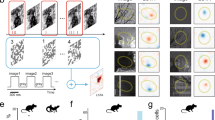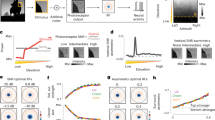Abstract
The visual system evolved to process natural images, and the goal of visual neuroscience is to understand the computations it uses to do this. Indeed the goal of any theory of visual function is a model that will predict responses to any stimulus, including natural scenes. It has, however, recently become common to take this fundamental principle one step further: trying to use photographic or cinematographic representations of natural scenes (natural stimuli) as primary probes to explore visual computations. This approach is both challenging and controversial, and we argue that this use of natural images is so fraught with difficulty that it is not useful. Traditional methods for exploring visual computations that use artificial stimuli with carefully selected properties have been and continue to be the most effective tools for visual neuroscience. The proper use of natural stimuli is to test models based on responses to these synthetic stimuli, not to replace them.
This is a preview of subscription content, access via your institution
Access options
Subscribe to this journal
Receive 12 print issues and online access
$209.00 per year
only $17.42 per issue
Buy this article
- Purchase on Springer Link
- Instant access to full article PDF
Prices may be subject to local taxes which are calculated during checkout

Similar content being viewed by others
References
Olshausen, B.A. & Field, D.J. How close are we to understanding V1? Neural Comput. 17, 1665–1699 (2005).
Lennie, P. & Movshon, J.A. Coding of color and form in the geniculostriate visual pathway. J. Opt. Soc. Am. A 22, 1–21 (2005).
Jones, J.P. & Palmer, L.A. The two-dimensional spatial structure of simple receptive fields in cat striate cortex. J. Neurophysiol. 58, 1187–1211 (1987).
Ringach, D.L. Spatial structure and symmetry of simple-cell receptive fields in macaque primary visual cortex. J. Neurophysiol. 88, 455–463 (2002).
Movshon, J.A., Thompson, I.D. & Tolhurst, D.J. Spatial summation in the receptive fields of simple cells in the cat's striate cortex. J. Physiol. (Lond.) 283, 53–77 (1978).
Adelson, E.H. & Bergen, J.R. Spatiotemporal energy models for the perception of motion. J. Opt. Soc. Am. A 2, 284–299 (1985).
Spitzer, H. & Hochstein, S. A complex-cell receptive-field model. J. Neurophysiol. 53, 1266–1286 (1985).
De Valois, K.K., De Valois, R.L. & Yund, E.W. Responses of striate cortex cells to grating and checkerboard patterns. J. Physiol. (Lond.) 291, 483–505 (1979).
Smith, M.A., Bair, W. & Movshon, J.A. Signals in macaque striate cortical neurons that support the perception of glass patterns. J. Neurosci. 22, 8334–8345 (2002).
Creutzfeldt, O.D. & Nothdurft, H.C. Representation of complex visual stimuli in the brain. Naturwissenschaften 65, 307–318 (1978).
Touryan, J., Lau, B. & Dan, Y. Isolation of relevant visual features from random stimuli for cortical complex cells. J. Neurosci. 22, 10811–10818 (2002).
Rust, N.C., Schwartz, O., Movshon, J.A. & Simoncelli, E.P. Spatiotemporal elements of macaque V1 receptive fields. Neuron 46, 945–956 (2005).
Shapley, R.M. & Enroth-Cugell, C. Visual adaptation and retinal gain controls. Prog. Retinal Res. 3, 263–346 (1984).
Bonds, A.B. Role of inhibition in the specification of orientation selectivity of cells in the cat striate cortex. Vis. Neurosci. 2, 41–55 (1989).
Geisler, W.S. & Albrecht, D.G. Cortical neurons: isolation of contrast gain control. Vision Res. 32, 1409–1410 (1992).
Heeger, D.J. Normalization of cell responses in cat striate cortex. Vis. Neurosci. 9, 181–197 (1992).
Carandini, M., Heeger, D.J. & Movshon, J.A. Linearity and normalization in simple cells of the macaque primary visual cortex. J. Neurosci. 17, 8621–8644 (1997).
Bair, W. & Movshon, J.A. Adaptive temporal integration of motion in direction-selective neurons in macaque visual cortex. J. Neurosci. 24, 7305–7323 (2004).
Maffei, L., Fiorentini, A. & Bisti, S. Neural correlate of perceptual adaptation to gratings. Science 182, 1036–1038 (1973).
Carandini, M., Movshon, J.A. & Ferster, D. Pattern adaptation and cross-orientation interactions in the primary visual cortex. Neuropharmacology 37, 501–511 (1998).
Sanchez-Vives, M.V., Nowak, L.G. & McCormick, D.A. Membrane mechanisms underlying contrast adaptation in cat area 17 in vivo. J. Neurosci. 20, 4267–4285 (2000).
Movshon, J.A. & Lennie, P. Pattern-selective adaptation in visual cortical neurones. Nature 278, 850–852 (1979).
Chance, F.S., Nelson, S.B. & Abbott, L.F. Synaptic depression and the temporal response characteristics of V1 cells. J. Neurosci. 18, 4785–4799 (1998).
Muller, J.R., Metha, A.B., Krauskopf, J. & Lennie, P. Rapid adaptation in visual cortex to the structure of images. Science 285, 1405–1408 (1999).
Hubel, D.H. & Wiesel, T.N. Receptive fields and functional architecture of monkey striate cortex. J. Physiol. (Lond.) 195, 215–243 (1968).
Blakemore, C. & Tobin, E.A. Lateral inhibition between orientation detectors in the cat's visual cortex. Exp. Brain Res. 15, 439–440 (1972).
Angelucci, A., Levitt, J.B. & Lund, J.S. Anatomical origins of the classical receptive field and modulatory surround field of single neurons in macaque visual cortical area V1. Prog. Brain Res. 136, 373–388 (2002).
Cavanaugh, J.R., Bair, W. & Movshon, J.A. Nature and interaction of signals from the receptive field center and surround in macaque V1 neurons. J. Neurophysiol. 88, 2530–2546 (2002).
Sceniak, M.P., Ringach, D.L., Hawken, M.J. & Shapley, R. Contrast's effect on spatial summation by macaque V1 neurons. Nat. Neurosci. 2, 733–739 (1999).
Keat, J., Reinagel, P., Reid, R.C. & Meister, M. Predicting every spike: a model for the responses of visual neurons. Neuron 30, 803–817 (2001).
Paninski, L., Pillow, J.W. & Simoncelli, E.P. Maximum likelihood estimation of a stochastic integrate-and-fire neural encoding model. Neural Comput. 16, 2533–2561 (2004).
Aguera y Arcas, B., Fairhall, A.L. & Bialek, W. Computation in a single neuron: Hodgkin and Huxley revisited. Neural Comput. 15, 1715–1749 (2003).
Simoncelli, E.P., Pillow, J.W., Paninski, L. & Schwartz, O. Characterization of neural responses with stochastic stimuli. in The Cognitive Neurosciences (ed. Gazzaniga, M.) 327–338 (MIT Press, Cambridge, Massachusetts, 2004).
Olshausen, B.A. & Field, D.J. Emergence of simple-cell receptive field properties by learning a sparse code for natural images. Nature 381, 607–609 (1996).
Barlow, H.B. Possible principles underlying the transformations of sensory messages. in Sensory Communication (ed. Rosenblith, W.A.) 217–234 (MIT Press, Cambridge, Massachusetts, 1961).
Bell, A.J. & Sejnowski, T.J. The independent components of natural scenes are edge filters. Vision Res. 37, 3327–3338 (1997).
van Hateren, J.H. & van der Schaaf, A. Independent component filters of natural images compared with simple cells in primary visual cortex. Proc. Royal Soc. Lond. B Biol. Sci. 265, 359–366 (1998).
Schwartz, O. & Simoncelli, E.P. Natural signal statistics and sensory gain control. Nat. Neurosci. 4, 819–825 (2001).
Chichilnisky, E.J. A simple white noise analysis of neuronal light responses. Network 12, 199–213 (2001).
Theunissen, F.E. et al. Estimating spatio-temporal receptive fields of auditory and visual neurons from their responses to natural stimuli. Network 12, 289–316 (2001).
David, S.V., Vinje, W.E. & Gallant, J.L. Natural stimulus statistics alter the receptive field structure of V1 neurons. J. Neurosci. 24, 6991–7006 (2004).
Touryan, J., Felsen, G. & Dan, Y. Spatial structure of complex cell receptive fields measured with natural images. Neuron 45, 781–791 (2005).
Sharpee, T., Rust, N.C. & Bialek, W. Analyzing neural responses to natural signals: maximally informative dimensions. Neural Comput. 16, 223–250 (2004).
Smyth, D., Willmore, B., Baker, G.E., Thompson, I.D. & Tolhurst, D.J. The receptive-field organization of simple cells in primary visual cortex of ferrets under natural scene stimulation. J. Neurosci. 23, 4746–4759 (2003).
Ringach, D.L., Hawken, M.J. & Shapley, R. Receptive field structure of neurons in monkey primary visual cortex revealed by stimulation with natural image sequences. J. Vis. 2, 12–24 (2002).
Prenger, R., Wu, M.C., David, S.V. & Gallant, J.L. Nonlinear V1 responses to natural scenes revealed by neural network analysis. Neural Netw. 17, 663–679 (2004).
Felsen, G., Touryan, J., Han, F. & Dan, Y. Cortical sensitivity to visual features in natural scenes. PLoS Biol. 3, e342 (2005).
Mante, V., Frazor, R.A., Bonin, V., Geislr, W.S. & Carandini, M. Independence of luminance and contrast in natural scenes and in the early visual system. Nat. Neurosci. 8 1690–1697 (2005).
Gross, C.G., Rocha-Miranda, C.E. & Bender, D.B. Visual properties of neurons in inferotemporal cortex of the macaque. J. Neurophysiol. 35, 96–111 (1972).
Acknowledgements
The authors thank E.P. Simoncelli for discussions.
Author information
Authors and Affiliations
Ethics declarations
Competing interests
The authors declare no competing financial interests.
Rights and permissions
About this article
Cite this article
Rust, N., Movshon, J. In praise of artifice. Nat Neurosci 8, 1647–1650 (2005). https://doi.org/10.1038/nn1606
Published:
Issue Date:
DOI: https://doi.org/10.1038/nn1606



